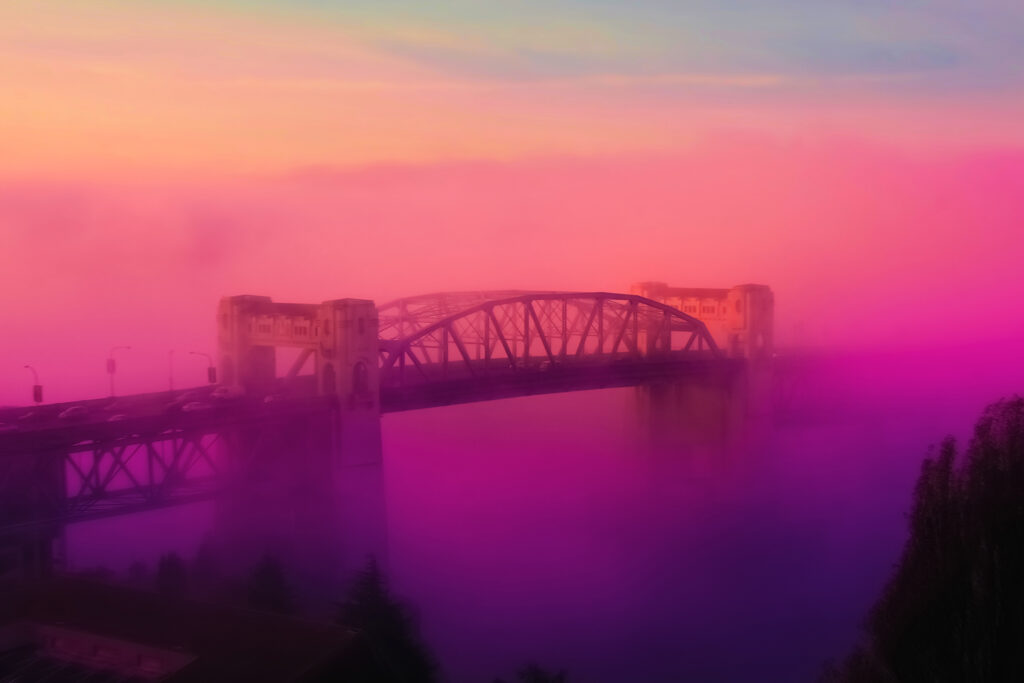
super saturates
A series of manipulated photographs exploring evidence of future climate impacts based on 500 years of landscape painting in and around volcanic events.
in a pink mist
Trevor Van den Eijnden
2020
c-print on acrylic
60×40 inches
From a soul is not made of atoms; text by curator Dr. Adrienne Fast
“Van den Eijnden is particularly interested in exploring the ways in which we, as human beings, experience time. He notes that some of the most groundbreaking work being done today in modern physics suggests that time as we understand it ceases to exist at the quantum level, and that although we experience time flowing from the past into the future, in a very real sense all time actually exists all the time. This realization has prompted the artist to explicitly reference both the past and the future in his work, as a kind of reaching both forward and backward in time to achieve what he calls “a remembrance of the future and an anticipation of the past.” This quality of Van den Eijnden’s work is particularly evident in a series of six large-scale photographs from the super saturates series (2007–ongoing). Immediately striking both due to their imposing scale and for their intense, candy-like hues, these photographs yield certain details on closer reading that complicate their immediate and visceral visual appeal.
The super saturates are landscape photographs taken by Van den Eijnden in British Columbia at specific moments when forest fire ash was dramatically altering the colour of the atmosphere and sky. After taking the photos almost instinctively, the artist struggled for a time to decide exactly how he wanted to use them. Inspiration came eventually from a scientific paper published in the journal Atmospheric Chemistry and Physics, in which the authors analyzed hundreds of historical landscape paintings looking for correlations between the colours of painted skies and known volcanic events that occurred between the years 1500 and 1900.1 By measuring the red-to-green ratios (R/G) of sunsets known to have been painted before, during, and following major volcanic eruptions, the authors of the paper were able to estimate 400 years of Aerosol Optical Depth (AOD), a measure of aerosols, particulates, smoke, and other forms of air pollution. Van den Eijnden was particularly interested in the data related to paintings by the nineteenth century British Romantic artist J.M.W. Turner, who quite famously painted a number of landscapes of erupting volcanoes, which invariably featured intensely coloured skies. According to the scientific paper, Turner painted skies with 76.7% enhanced RIG values in 1818, 79.2% in 1832, and 97.7% in 1835, in each case corresponding to a known volcanic event.
Using this data as a guide, Van den Eijnden returned to his original photos with the intention of intensifying their original colours, using the measurements of Turner’s sunsets as a guide. In some cases Van den Eijnden has altered his images quite significantly, in other cases only very slightly. But in none of the photos does he introduce any entirely new colours; rather, he ramps up the existing saturation in order to present what the artist calls “hypothetical future landscapes.” In these photographs Van den Eijnden hypothesizes that the vibrancy and colour of our skies is going to change dramatically in the future as a result of climate change. In this way, the super saturates reach back in time-to specific nineteenth century environmental events, and how they became encoded in art history-in order to tell a predictive future. The work suggests that we can look to past environmental disasters to find a glimpse of what our future baselines may become.
The super saturates also introduce another common theme that runs through the artist’s practice: the experience of ecological grief caused by the current Anthropocene era, and the intensity with which contemporary behaviours continue to damage the environment.
1 Zerefos, C. S., Gerogiannis, V. T., Balis, D., Zerefos, S. C., and Kazantzidis, A., “Atmospheric Effects of Volcanic Eruptions as Seen by Famous Artists and Depicted in Their Paintings,” Atmospheric Chemistry and Physics, 110. 7 (2007), 4027-4042. https://acp.copernicus.org/articles/7/4027/2007/acp-7-4027-2007.pdf




